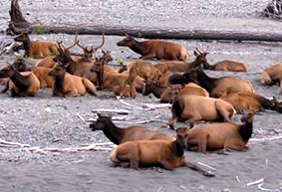|
The malleus, incus, and stapes (hammer, anvil, and stirrup) are the middle ear bones responsible for magnifying and conducting sound received from the outer to the inner ear in mammals. In their embryonic stage, mammals have their ear bones still attached to the lower jaw implying that the middle ear bones evolved from bones of the lower jaw. The malleus is formed from the embryonic prearticular and articular, and the incus is derived from the quadrate bone. Indeed, in therapsids and other vertebrates with jaws, the lower jaw is made up of a number of bones (dentary and a series of additional bones) rather than just of one jawbone like in modern mammals. Therapsid fossils show an obvious trend through time for an increase in size of the dentary, including formation of a coronoid process , and reduction of the postdentary elements of the lower jaw. Even when they were a functional jaw articulation, the articular and quadrate probably passed sound vibrations received by the lower jaw to the stapes.
The stapes evolved from a fish a bone known as the hyomandibula responsible for orchestrating feeding and breathing movements in fish. During the Devonian, the hyomandibula shrank in size and got lodged in a hole in the braincase, where it became the stapes. However, it would take millions of years before the stapes would take on its role as a part of the terrestrially adapted middle ear. In the meantime, what later became the stapes functioned in aquatic tetrapods (i.e. in Acanthostega that had evolved from fish) as a structural part of the skull.
Recent studies of jaw and ear function in primitive mammal-like reptiles indicate that the larger angular bone, which later became the tempanic ( bone of the skull, partially enclosing the middle ear and supporting the eardrum ) may have supported an eardrum while still part of the lower jaw. However, once the dentary bone made a new jaw hinge with the skull in the immediate predecessor of mammals, the accessory jawbones may have no longer functioned to supporting the jaw but evolved into the middle ear sound-transmitting function.
Scientist can only speculate why the middle ear and dentary of mammals evolved? Selection for endothermy may have driven changes in the jaw and middle ear. Being endothermic and covered in hair allowed mammals to be active when competing reptiles were too cold to move like for instance at night. However, being endothermic came with a cost. For instance, a cotton rat has to consume around 70% of the calories for this purpose. Thus, the necessity for increased efficiency of biting and chewing may have led to changes in the lower jaw which bears the teeth. The lower jaw needed to be strong and not have sutures between bones that are weak points. The growth of a coronoid process (sharp triangular projection from dentary) provided more space for attaching muscle to increase the strength of the bite.
At the same time, selection for increasing hearing sensitivity might have resulted in less-firmly attached quadrate and articular allowing them to vibrate more freely, transmitting sound energy from the angular and articular through the quadrate to the stapes. Acute hearing as having vibrissae would have been important when being active at night.
Continue on page 4
|
|


The Roosevelt Elk (Cervus canadensis) is the largest of the four subspecies of elk living in North America © Madeleine Peytrignet

|









